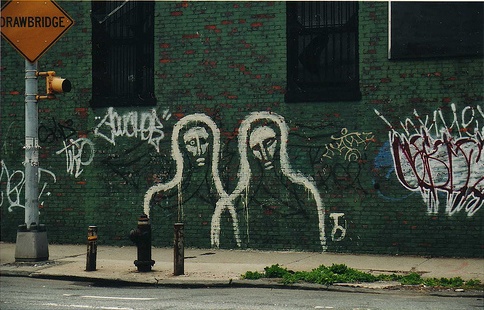
A local story. The Brooklyn Museum has been availing itself of various services at Flickr in conjunction with its new “Grafitti” exhibit, assembling photo sets and creating a group photo pool. In addition, the museum welcomes anyone to contribute photographs of grafitti from around Brooklyn to be incorporated into the main photo stream, along with images of a growing public grafitti mural on-site at the museum where visitors can pick up a colored pencil and start scribbling away. Here’s a picture from the first week of the mural:

This is an interesting case of a major cultural institution nurturing an outer curatorial ring to complement, and even inform, a central exhibit (the Institute conducted a similar experiment around Christo’s Gates installation in Central Park, 2005). It’s especially well suited to a show about grafitti, which is already a popular subject of amateur street photography. The museum has cleverly enlisted the collective eyes of the community to cover a terrain (a good chunk of the total surface area of Brooklyn) far too vast for any single organization to fully survey. (The quip has no doubt already been made that users be sure not forget to tag their photos.)
Thanks, Alex, for pointing this out.
Category Archives: photography
truth through the layers
 Pedro Meyer’s I Photograph to Remember is a work originally designed for CD ROM, that became available on the Internet 10 years later. I find it not only beautiful within the medium limitations, as Pedro says on his 2001 comment, but actually perfectly suited for both, the original CD ROM, and its current home on the internet . It is a work of love, and as such it has a purity that transcends all media.
Pedro Meyer’s I Photograph to Remember is a work originally designed for CD ROM, that became available on the Internet 10 years later. I find it not only beautiful within the medium limitations, as Pedro says on his 2001 comment, but actually perfectly suited for both, the original CD ROM, and its current home on the internet . It is a work of love, and as such it has a purity that transcends all media.
The photographs and their subject(s) have such degree of intimacy that forces the viewer to look inside and avoid all morbidity or voyeurism. The images are accompanied by Pedro Meyer’s voice. His narration, plain and to the point, is as photographic as the pictures are eloquent. The line between text and image is blurred in the most perfect b&w sense. The work evokes feelings of unconditional love, of hands held at moments of both weakness and strength, of happiness and sadness, of true friendship, which is the basis of true love. The whole experience becomes introspection, on the screen and in the mind of the viewer.
IPTR was originally a Voyager CD ROM, and it was the first ever produced with continuous sound and images, a possibility that completes, and complements, image as narration and vice-versa. The other day Bob Stein showed me IPTR on his iPod and expressed how perfectly it works on this handheld device. And, it does. IPTR is still a perfect object, and as those old photographs exist thanks to the magic of chemicals and light, this exists thanks to that “old” CD ROM technology, and will continue to exist inhabiting whatever medium necessary to preserve it.
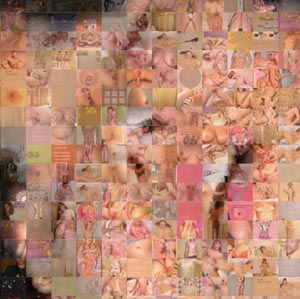 I’ve recently viewed Joan de Fontcuberta’s shows in two galleries in Manhattan; Zabriskie and Aperture,) and the connections between IPTR and these works became obsessive to me. Fontcuberta, also a photographer, has chosen the Internet, and computer technology, as the media for both projects. In “Googlegrams,” he uses the Google image search engine to randomly select images from the Internet by controlling the search engine criteria with only the input of specific key words.
I’ve recently viewed Joan de Fontcuberta’s shows in two galleries in Manhattan; Zabriskie and Aperture,) and the connections between IPTR and these works became obsessive to me. Fontcuberta, also a photographer, has chosen the Internet, and computer technology, as the media for both projects. In “Googlegrams,” he uses the Google image search engine to randomly select images from the Internet by controlling the search engine criteria with only the input of specific key words.
These Google-selected images are then electronically assembled into a larger image, usually a photo, of Fontcuberta’s choosing (for example, the image of a homeless man sleeping on the sidewalk reassembled from images of the 24 richest people in the world, Lynddie England reassembled from images of the Abu Ghraib’s abuse, or a porno picture reassembled from porno sites.). The end result is an interesting metaphor for the Internet and the relationship between electronic mass media and the creation of our collective consciousness.
For Fontcuberta, the Internet is “the supreme expression of a culture which takes it for granted that recording, classifying, interpreting, archiving and narrating in images is something inherent in a whole range of human actions, from the most private and personal to the most overt and public.” All is mediated by the myriad representations on the global information space. As Zabriskie’s Press Release says, “the thousands of images that comprise the Googlegrams, in their diminutive role as tiles in a mosaic, become a visual representation of the anonymous discourse of the internet.”
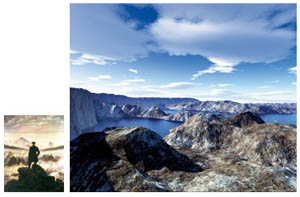 Aperture is showing Fontcuberta’s “Landscapes Without Memory” where the artist uses computer software that renders three-dimensional images of landscapes based on information scanned from two-dimensional sources (usually satellite surveys or cartographic data.) In “Landscapes of Landscapes” Fontcuberta feeds the software fragments of pictures by Turner, Cézanne, Dalí, Stieglitz, and others, forcing the program to interpret this landscapes as “real.”
Aperture is showing Fontcuberta’s “Landscapes Without Memory” where the artist uses computer software that renders three-dimensional images of landscapes based on information scanned from two-dimensional sources (usually satellite surveys or cartographic data.) In “Landscapes of Landscapes” Fontcuberta feeds the software fragments of pictures by Turner, Cézanne, Dalí, Stieglitz, and others, forcing the program to interpret this landscapes as “real.”
These painted and photographic landscapes are transformed into three-dimensional mountains, rivers, valleys, and clouds. The result is new, completely artificial realities produced by the software’s interpretation of realities that have been already interpreted by the painters. In the “Bodyscapes” series, Fontcuberta uses the same software to reinterpret photographs of fragments of his own body, resulting in virtual landscapes of a new world. By fooling the computer Fontcuberta challenges the limits between art, science and illusion.
Both Pedro Meyer and Joan de Fontcuberta’s use of photography, technology and the Internet, present us with mediated worlds that move us to rethink the vocabulary of art and representation which are constantly enriched by the means by which they are delivered.
.tv
People have been talking about internet television for a while now. But Google and Yahoo’s unveiling of their new video search and subscription services last week at the Consumer Electronics Show in Las Vegas seemed to make it real.
Sifting through the predictions and prophecies that subsequently poured forth, I stumbled on something sort of interesting — a small concrete discovery that helped put some of this in perspective. Over the weekend, Slate Magazine quietly announced its partnership with “meaningoflife.tv,” a web-based interview series hosted by Robert Wright, author of Nonzero and The Moral Animal, dealing with big questions at the perilous intersection of science and religion.

Launched last fall (presumably in response to the intelligent design fracas), meaningoflife.tv is a web page featuring a playlist of video interviews with an intriguing roster of “cosmic thinkers” — philosophers, scientists and religious types — on such topics as “Direction in evolution,” “Limits in science,” and “The Godhead.”
This is just one of several experiments in which Slate is fiddling with its text-to-media ratio. Today’s Pictures, a collaboration with Magnum Photos, presents a daily gallery of images and audio-photo essays, recalling both the heyday of long-form photojournalism and a possible future of hybrid documentary forms. One problem is that it’s not terribly easy to find these projects on Slate’s site. The Magnum page has an ad tucked discretely on the sidebar, but meaningoflife.tv seems to have disappeared from the front page after a brief splash this weekend. For a born-digital publication that has always thought of itself in terms of the web, Slate still suffers from a pretty appalling design, with its small headline area capping a more or less undifferentiated stream of headlines and teasers.
Still, I’m intrigued by these collaborations, especially in light of the forecast TV-net convergence. While internet TV seems to promise fragmentation, these projects provide a comforting dose of coherence — a strong editorial hand and a conscious effort to grapple with big ideas and issues, like the reassuringly nutritious programming of PBS or the BBC. It’s interesting to see text-based publications moving now into the realm of television. As Tivo, on demand, and now, the internet atomize TV beyond recognition, perhaps magazines and newspapers will fill part of the void left by channels.
Limited as it may now seem, traditional broadcast TV can provide us with valuable cultural touchstones, common frames of reference that help us speak a common language about our culture. That’s one thing I worry we’ll lose as the net blows broadcast media apart. Then again, even in the age of five gazillion cable channels, we still have our water-cooler shows, our mega-hits, our television “events.” And we’ll probably have them on the internet too, even when “by appointment” television is long gone. We’ll just have more choice regarding where, when and how we get at them. Perhaps the difference is that in an age of fragmentation, we view these touchstone programs with a mildly ironic awareness of their mainstream status, through the multiple lenses of our more idiosyncratic and infinitely gratified niche affiliations. They are islands of commonality in seas of specialization. And maybe that makes them all the more refreshing. Shows like “24,” “American Idol,” or a Ken Burns documentary, or major sporting events like the World Cup or the Olympics that draw us like prairie dogs out of our niches. Coming up for air from deep submersion in our self-tailored, optional worlds.
another view on the stacey/gamma flap
For an alternative view of Lisa’s earlier post … i wonder if Gamma’s submission of Adam Stacey’s image with the “Adam Stacey/Gamma” attribution doesn’t show the strength of the Creative Commons concept. As i see it, Stacey published his image without any restrictions beyond attribution. Gamma, a well-respected photo agency started distributing the image attributed to Stacey. Isn’t this exactly what the CC license was supposed to enable — the free-flow of information on the net. perhaps Stacey chose the wrong license and he didn’t mean for his work to be distributed by a for-profit company. If so, that is a reminder to all of us to be careful about which Creative Commons license we choose. One thing i’m not clear on is whether Gamma referenced the CC license. They are supposed to do that and if they didn’t they should have.
are we real or are we memorex
i saw four live performances and a dozen gallery shows over the past few days; one theme kept coming up– what is the relationship of simulated reality to reality. here are some highlights and weekend musings.
thursday night: “Supervision,” a play by the Builders Association and DBox about 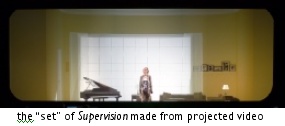 the infosphere which seems to know more about us than we do — among other things “it” never forgets and rarely plays mash-up with our memories the way human brains are wont to do. the play didn’t shed much light on what we could or should do about the encroaching infosphere but there was one amazing moment when video started shooting from left to right across the blank wall behind the actors. within moments a complete set was “constructed” out of video projections — so seamlessy joined at the edges and so perfectly shot for the purpse that you quickly forgot you were looking at video.
the infosphere which seems to know more about us than we do — among other things “it” never forgets and rarely plays mash-up with our memories the way human brains are wont to do. the play didn’t shed much light on what we could or should do about the encroaching infosphere but there was one amazing moment when video started shooting from left to right across the blank wall behind the actors. within moments a complete set was “constructed” out of video projections — so seamlessy joined at the edges and so perfectly shot for the purpse that you quickly forgot you were looking at video.
friday night: Nu Voices six guys making amazing house music, including digitized-sounding vocals, entirely with their voices. one of the group, Masai Electro, eerily imitated the sounds laurie anderson makes with her vocoder or that DJs make when they process vocals to sound robotic. the crowd loved it which made me wonder why we are so excited about hearing a human pretend to be a machine? i asked masai electro why he thinks the audience likes what he does so much. he had never been asked the question before and evidently hadn’t thought about it, but then spontaneously answered “because that’s where we’re going” meaning that humans are becoming machines or at least are becoming “at one” with them.
saturday afternoon: Clifford Ross’ very large landscapes (13′ x 6′) made with a super high resolution surveillance camera. a modern attempt at hudson river school lush landscapes. because of the their size and detail, you feel as if you are looking out a window at reality; makes you long for the “natural world” most of us rarely encounter.
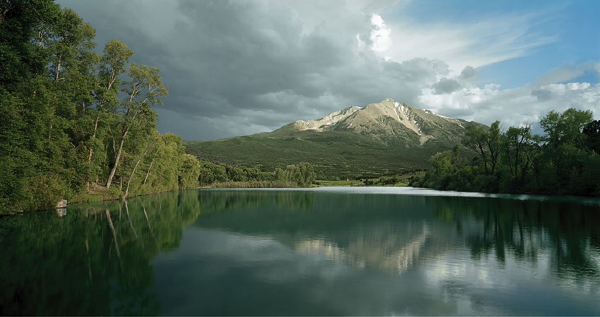
left with a bunch of questions
does it make a difference if our experience is “real” or “simulated.” does that way of looking at things even make sense anymore. when we manage to add the smell of fresh air, the sound of the wind, the rustle of the grass, the bird in flight and the ability to walk around in life-size 3-D spaces to the clifford ross photos, what will be the meaningful difference between walking in the countryside and opening the latest “you are there” coffee table book of the future. in a world with limited resources i can see the value of subsituting vicarious travel for the real thing (after all if all 7 billion of us traipsed out to the galapagos during our lifetimes, the “original” would be overrun and despoiled, turning it into its opposite). but what does it mean if almost all of our experience is technologically simulated and/or mediated?
Pedro Meyer in his comment about digitally altered photos says that all images are subjective which makes altered/not-altered a moot distinction. up until now the boundary between mediated objects and “reality” was pretty obvious, but i wonder if that changes when the scale is life-like and 3D. the Ross photos and the DBox video projections foreshadow life-size media which involves all the senses. the book of the future may not be something we hold in our hands, it might be something a 3-dimensional space we can inhabit. does it make any difference if i’m interacting only with simulacra?
hacking nature
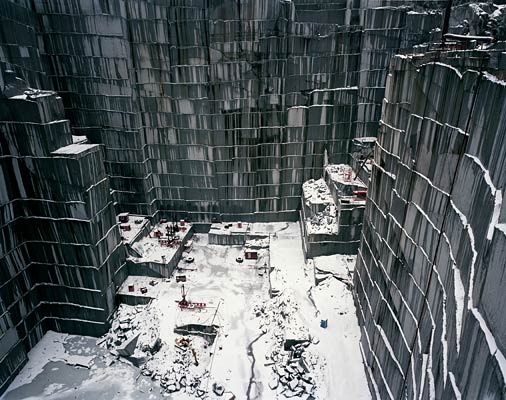
Slate is trying something new with its art criticism: a new “gallery” feature where each month an important artist will be discussed alongside a rich media presentation of their work.
…we’re hoping to emphasize exciting new video and digital art–the kind of art that is hard to reproduce in print magazines.
For their first subject, they don’t push the print envelope terribly far (just a simple slideshow), but they do draw attention to some stunning work by Canadian photographer Edward Burtynsky, who (happily for us New Yorkers) has shows coming this week to the Brooklyn Museum and the Charles Cowles Gallery in Manhattan. Burtynsky documents landscapes bearing the mark of extreme human exploitation – the infernal streams flowing from nickel mines, junked ocean liners rusting in chunks on the beach, abandoned quarries ripe with algae in their cubic trenches, and an arresting series from recent travels through China’s industrial belt.
These photographs carry startling information through the image-surplussed web. But Burtynsky disappoints in one vital, perhaps deciding, respect:
…his position on the moral and political implications of his work is studiously neutral. He doesn’t point fingers or call for change; instead, he accepts industry’s exploitation of the land as the inevitable result of modern progress. “We have extracted from the land from the moment we stood on two feet,” he said in an interview in the exhibition catalog. “The entire 20th century has been a revving up of this large consumptive engine. It’s not a question of whether we are going to stop consuming. It’s not going to happen…”
As someone who believes that struggling to prevent (or at least mitigate) global ecological disaster should be the transcending narrative of our times, I find Burtynsky’s detachment deeply depressing and self-defeating. His images glory in the sick beauty of these ravaged scenes, and the cultural consumers that will no doubt pay large sums for these photographs at his upcoming Chelsea show only compound the cynicism.
“imaginative keyword conversations” – playing flickr on public screens
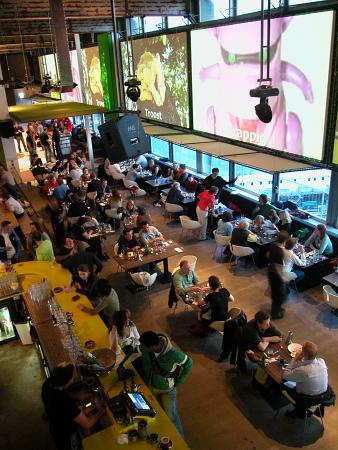
A wonderful hack of public space in Amsterdam. And on the top floor of the PostCS building no less, with breathtaking panoramic views of the city. Kim and I had the pleasure of spending two days there this past January at “A Decade of Web Design.”
The diners in bar/restaurant/club 11 will be subjected to the wrath of fellow visitors SMSing whatever keyword they want to the installation that pulls photos from the online community flickr and projects them onto Restaurant 11’s huge panoramic screens.
(via Smart Mobs)
